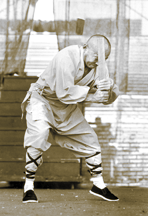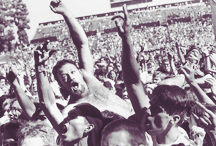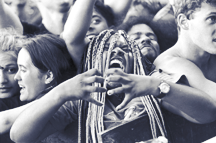Headbanger Boogie
Views from the stands at San Jo-palooza
Photographs by George Sakkestad; text by Nicky Baxter and Bernice Yeung
'FIFTEEN SHAVEN-headed Chinamen in orange robes" (as the Shaolin Kungfu of China are described in the festival's program) took Lollapalooza's main stage between Rancid and Screaming Trees to demonstrate feats of flexibility, strength and discipline. Basic Zen principles were also explained to the audience during the exhibition, but such enlightened ideas flew right over the headbanging heads of Lollapalooza '96 attenders. Roars of appreciation came during fighting sequences, which to some resembled a Street Fighter video game. "Yeeeaaah, monks!" hollered the tattooed character seated in front of me, drowning out the narration on inner peace that accompanied the dazzling moves.
Metroactive's exclusive Lollapalooza photo essay.
The irony of the Shaolin Monk demonstration was no isolated event; Lollapalooza '96 was not the mind-opening, politically correct festival that it has been in the past. The "Brain Trough," a tiny tent of political organizations, seemed to attract attention only because shade and free Trojan condoms were available. Other political booths on site were overshadowed by band merchandise or drowned out by loud, raucous noise from the second or third stages. Lollapalooza '96 was a real Lollapaloser, dominated by ignorance, excessive slam-dance violence, fashion faux pas and mediocre music.
With all the radio station music festival hype (Live 105's BFD, Kamp KOME and KMEL Summer Jam), Lollapalooza '96 could easily have passed as a KSJO-sponsored event. The classic rock station's paraphernalia reigned: an estimated two of every five people sported T-shirts or temporary tattoos. Outfitted in faded Metallica concert tees and with air guitars strapped across beer bellies, the crowd fit the bad metal stereotypes offered up nightly on Beavis and Butthead. Even the festival's lineup was straight out of the station's turn-it-up programming, with enough power chords and electric guitar solos to blow the fuse boxes in neighboring cities.
The second and third stages also raged with edgy bellicosity. Thirty Ought Six was a violent display of musicianship; vocals were a painful off-key screaming. The Melvins, the perpetual earsore, made an appearance on the second stage and weren't even booed off.
Perhaps the only redeeming act was New York's Soul Coughing, the "only quasi-alternative hip-hop group with an all-Jewish rhythm section," as vocalist/guitarist Mark Doughty describes the band. Soul Coughing eschews the conventional and celebrates the unorthodox by blending funk guitar, hip-hop beats, a gyrating upright bassline and smooth synth sampling. Every sound becomes a note; unlike many of the bands present, Soul Coughing constructed music out of noise instead of the other way around.
Given the show's headliner--Metallica--the festival's tendencies toward aggressive sound wasn't a surprise. But if amped-up instruments and squealing guitar solos weren't your thing, then the festival lacked variety. Except for a back-to-back punk fling with Rancid and the Ramones, and Devo's hijinks and nutty costume changes on the main stage, Lollapalooza '96 was a headbanger's ball.
Merchandising and Melvinizing
I FELT A LITTLE SORRY for the half-dressed masses huddled round San Jo-palooza's many makeshift booths manned and womaned by vendors. Some of the deals would make a used-car sales individual smile. But this frugal shoppercumrock writer held firm, and by the end of the day I was a one-man caravan loaded down with exotic clothing, trinkets and other useless knickknacks. Sure, the browbeating tactics reduced a few sellers to tears, but business is business. And Lollapalooza's inaugural debut at Spartan Stadium on Saturday did some pretty impressive business; it was hot in more ways than one.
Which is great--except for the parking, which wasn't. Undaunted by the hike, I arrived just in time to witness Third Stagers Thirty Ought Six's set being broken down. Next up was Scottish group Long Fin Killie. Fronted by a really cute colored guy with dreadlocks, Killie rated low nevertheless. Where were the kilts?
On the second stage, meanwhile, the Melvins had just commenced. Kilts or no, the Melvins rocked the crowd like the great shake of '89. Having finally gotten a shot at bringing the noise to a larger market, the threesome's 45-minute set was unsparing, borderline assaultive. True, the Melvins' sonic mayhem is as anachronistic as afros, but try telling that to the pit-boys or fans on the periphery who got their ear-ringing jollies off as well.
After the Melvins were through with melting down the eardrums of the sweating sea of rockists, I caught the Ramones in action on the main stage. Even far away in the bleachers, it was difficult not to get all nostalgic; after all, this might well be their final tour. Ten years or so had elapsed since the first time I'd seen Joey and his "brothers" in concert; it was at a New Year's Eve show at a downtown San Jose venue. Incredibly, they were opening for Tubes. Now a main-stage act, the trio was finally getting theirs, albeit belatedly.
Back down on the second stage, Sponge had just hit. Interestingly, Sponge is one of a number of post-plaid bands dismissed by pundits surveying who was gonna be who in '96. Something about the Detroit outfit's platinum-snatching debut, Rotting Pinata, whose title track became a ubiquitous buzzer, may have pushed the wrong button--the one reading "overnight success." But the pundits were wrong about Sponge. Of the bands I focused on, it was Sponge that hijacked the most attention. In terms of sheer energy, musicality--the whole nine--this quintet presented a complete package. And the audience (one of the largest for a non-main stage lineup) reacted to Sponge as if the latter were on its way up, not out.
The majority of Lolla-pals were here to see Metallica and/or Soundgarden. From what I heard, they got their money's worth. But by then I was more concerned with getting the day's haul into the trunk of my rickety rig.
[ Metro | Metroactive Central | Archives ]
This page was designed and created by the Boulevards team.

Bang: A monk catches the spirit.


Hand-Raising Experience: Raucous noise, crowd-surfing and slam-dancing ruled at San Jose's first Lollapalooza.
Bernice Yeung

Mosh Hour: A Lolla-pal hugs the front-row barrier for Soundgarden's set.
Nicky Baxter
From the August 8-14, 1996 issue of Metro
